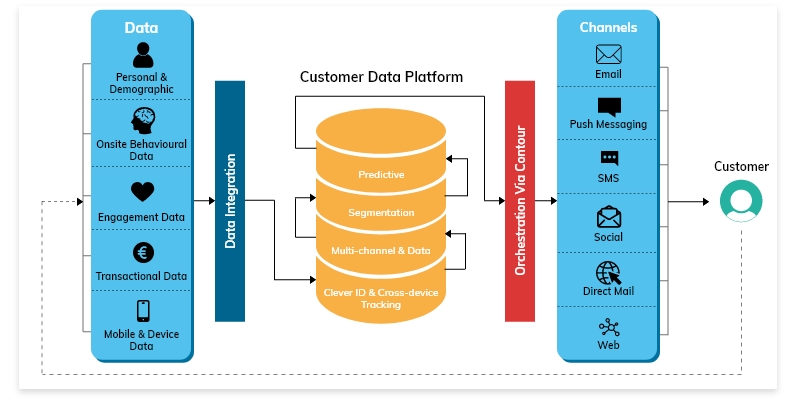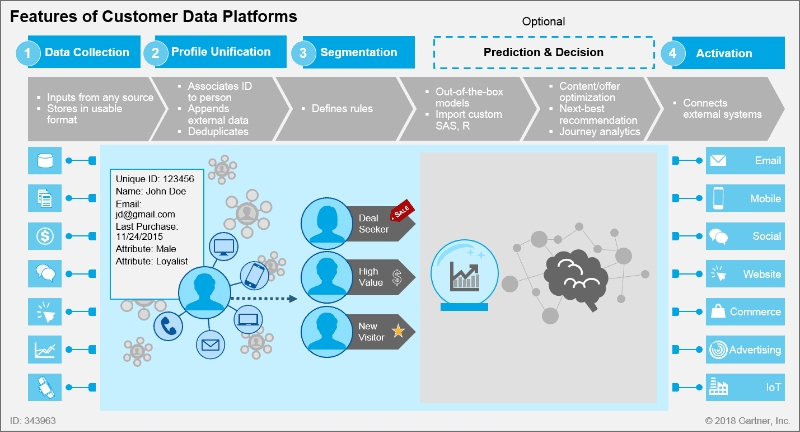Today, more than ever, businesses require a direct relationship with their customers across all touchpoints. A Customer Data Platform can help marketers organise their data, improve audience segmentation, manage campaigns, enhance digital experience, streamline cross-channel marketing orchestration and optimise customer analytics.
However, the sheer amount of time and effort needed to collect, separate, and segment your customers, leads, and existing clients into the appropriate categories are enormous. The best way to explain this is with an example, but first, let’s go over some challenges and statistics on why a CDP can be your enterprise’s golden ticket to business growth.
Fact checks!
- Acquia reports that 80% of customers value the brand experience as much as the products themselves.
- 90% of leading marketers say personalisation significantly contributes to business profitability (Google)
- More than half of marketers said payback was achieved within 6 months, and 4 out of 5 saw positive ROI within 12 months on implementing a CDP solution. (Tealium 2022 State of the CDP, January 2022)
Numbers don’t lie. Now that you know what’s happening and what’s gaining momentum faster than any other marketing technology, how can your business keep track of customer data and deliver personalised experiences across an ever-expanding set of touchpoints?
So, let’s take a real-life example to see the value the CDP can bring to your marketing campaigns. Think you are on the hunt for a new sports shoe (or anything you like). Perhaps, your research process will look something like this:

However, it is not the end of the journey. You may have noticed that each interaction with the brand resulted in a more personalised experience. The social media advertising you saw was incredibly relevant to you; the brand’s website has made tiny tweaks to personalise website content, push notifications and marketing emails.
How was the brand achieving all of this? And how can your brand offer a similar customer experience?
Customer Data Platform Defined
CDP – “an enterprise software that collects and unifies data across channels and systems to create a single source of truth for customer data. It pulls together zero-, first-, and third-party data to build comprehensive 360º customer profiles and updates them in real-time. It gives marketers the intelligence to recommend products and services on the right channel with the right message at the right time.”

The digital sources that feed CDPs may include:
- Behavioral data from a website, mobile apps, digital products and purchases, IoT devices, social media platforms, and net promoter score.
- Transactional data from e-commerce or point of sale (POS) systems
- Demographic data, including names, birth dates, and addresses
Following the data-collecting process, the second pillar of a CDP is the integrations that allow you to use various types of data within the platform. You can convert this data into gold by integrating data from different systems into one single source of truth – a unique customer identity. With the insights gained from this data, you can create highly tailored and contextualised campaigns, trigger specific actions in your customer’s journey, and stitch the customer experience across channels and devices seamlessly.
What’s What: CDPs vs. CRMs vs. DMPs, and Which do You Need?
CDPs are not the same as Customer Relationship Management Systems (CRMs) and Data Management Platforms (DMPs). Although these systems are sometimes confused with one another, each is unique and utilised for specific organisational functions.
Customer Relationship Management Systems (CRMs)
CRMs track customer interactions. These are generally used by your team’s customer-facing engagements, such as sales and customer service reps. In a nutshell, CRMs manage customer connections, whereas CDPs manage customer data.
Data Management Platforms (DMPs)
A data management platform (DMP) collects anonymous data from the web and applications to run digital advertising and target (segment) ads more efficiently.
Data from CRMs and DMPs can be fed into a CDP. Data automatically or manually collected about your consumers can be put into your central data repository and used to understand your audience better.
When does a CDP make more sense than CRM and DMP?
44% of organisations surveyed by Forbes Insights report that a CDP helps drive customer loyalty and ROI for their organisation.
- Real-time data for real-time execution and eliminate batch processing.
- Track customer journeys across various touchpoints
- Ensures compliance (Governance and Legislation – CCPA, GDPR)
Now that the main differences between a CDP and other data solutions are clear, what features should I look for in a customer data platform?
Data collection: Seeing your customer data as it is generated enables you to modify your data analysis process more quickly.
Ability to link to marketing and sales platforms: Your CDP must be able to collect data from the sources you use, such as marketing tools, web/app analytics, and e-commerce.
Security and GDPR/regulatory compliance: If you are not in accordance with local and international regulations while managing consumer data, you are jeopardising your company’s future.
Easy querying and usability: Your marketing employees need to be able to quickly implement new technologies. Non-technical users must be able to access and query data successfully to provide relevant insights to drive business decisions.
Tools for migration: Things don’t always go as planned. It is dangerous to select any software package that encrypts your data and does not include a technique for exporting it if you decide to migrate platforms.
Identity resolution and segmentation: Raw data must be cleansed, formatted, and associated with specific visitors or service users. It must also be possible to identify broader user behaviours to target future marketing initiatives effectively.
The entire process looks something like this:

Source: Gartner
CDPs offer a broad range of benefits, including:
- Achieving a true centralised 360-degree view of the customer
- Connecting customer data to other applications to enhance analytics
- Improving operational efficiency and cost savings on your tech stack
- Increasing revenue and customer lifetime value (CLV)
- Ensuring data protection and privacy
- Streamlining customer experience
So, how do I go about getting it? Getting a CDP for your enterprise’s digital transformation requires some serious thinking. The next step toward understanding your customers is choosing the right CDP solution. Once you’ve mapped out your customer data platform journey, it’s time to choose a vendor.
If you want to learn more about the customer data platform and the use of a unified customer experience, let’s connect!
Notes and Source:
- https://www.forbes.com/sites/insights-treasuredata/2018/06/20/the-rise-of-the-customer-data-platform-and-what-it-means-to-businesses/#6210001353a1
- https://cdp.com/articles/basics/cdp-industry-statistics/
- https://ninetailed.io/blog/personalization-statistics/
- https://www.gartner.com/en/marketing/research/2020-marketing-technology-survey
- https://www.acquia.com/blog/customer-data-platform

